Dancing Frog flies kites in
China and Japan -- Spring 1999
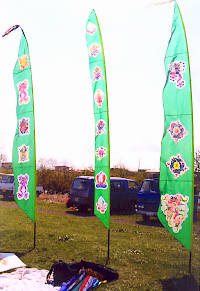
Dancing Frog Banners at Fujisaki festival
Jennifer Snyder and Bob Harris traveled to China and Japan attending 2 festivals in each country. We were welcomed with very gracious feelings. Our eyes were continually filled with beauty.
China
We flew from San Francisco to Beijing, China to attend kite festivals in Lianyungang and Weifang. China is moving into the 21st century at a rapid pace. Old buildings are being torn down and huge new buildings are being erected in their place, 5 square blocks at the base. New Jeep Cherokees and cell phones are everywhere. McDonalds was across the street, as was KFC, Starbucks and other corporate fast foods from the US; old and the new side by side.
We traveled 17 hours south to Lianyungang, a port town, by overnight train.
We reserved the "soft sleeper" compartments which were 4 bunks to a compartment, with a locking door. The train was a run down old train, and had seen many tracks. Kite flyers from Canada (Mel Edlund, and Wayne Pattison), the Isle of Man (Bill Jones and Joan Wilson), China, and an American from Japan, Ed Fackler (Edo) were all traveling on the train to the Lianyungang kite festival. The countryside was flat and every arable piece of land was under cultivation. Every once in a while there would be a circular mound of dirt 5 feet high, a burial mound. These were solitary and in groups dotting the countryside. The next morning we were ready to get off the train and fly kites.
Lianyungang
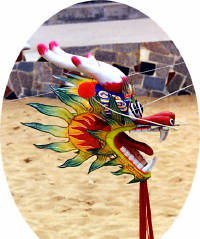 The Chinese kite committee arranged for us to be met at the train by student interpreters and we were escorted to our hotel. The hotel (more like an American motel) was clean and on the outskirts of town, near the beach. This was to be a day free, and the ceremony opening the 5th China International Kite Festival would be the following morning. Being the kite fliers we were, a group of us decided to go to the beach and fly some kites. Among this group was a kite maker Yang Huan Xing from Beijing, and his wife Li Hua, a Chinese rocket scientist who arranged for a mini bus to drive us to the beach. Surprisingly we were taken to the very beach the festival would be held at the next day. As we walked to the beach to fly our kites, we realized we walked into the Chulan Cup - the 9th National Kite Competition of China. A wonderful opportunity to watch the Chinese kite makers and flyers competing amongst themselves. The Dragon (centipede) kites were competing as we walked onto the beach. The scene of 10-20 Dragon kites filling the air at the same time was incredible. Many of them had time release firecrackers hanging from their mouths which were exploding as the dragon kite flew into the air. As some of the kites came down we were able to look closely at them, marveling at the beautiful artwork. Some were constructed with windmills on the side to drive mechanical links which made eyebrows move, tongues dart in and out, and the eyes roll about. The kites were constructed of bamboo frames, with silk or paper stretched over the frame and painted.
The Chinese kite committee arranged for us to be met at the train by student interpreters and we were escorted to our hotel. The hotel (more like an American motel) was clean and on the outskirts of town, near the beach. This was to be a day free, and the ceremony opening the 5th China International Kite Festival would be the following morning. Being the kite fliers we were, a group of us decided to go to the beach and fly some kites. Among this group was a kite maker Yang Huan Xing from Beijing, and his wife Li Hua, a Chinese rocket scientist who arranged for a mini bus to drive us to the beach. Surprisingly we were taken to the very beach the festival would be held at the next day. As we walked to the beach to fly our kites, we realized we walked into the Chulan Cup - the 9th National Kite Competition of China. A wonderful opportunity to watch the Chinese kite makers and flyers competing amongst themselves. The Dragon (centipede) kites were competing as we walked onto the beach. The scene of 10-20 Dragon kites filling the air at the same time was incredible. Many of them had time release firecrackers hanging from their mouths which were exploding as the dragon kite flew into the air. As some of the kites came down we were able to look closely at them, marveling at the beautiful artwork. Some were constructed with windmills on the side to drive mechanical links which made eyebrows move, tongues dart in and out, and the eyes roll about. The kites were constructed of bamboo frames, with silk or paper stretched over the frame and painted.
After seeing so many dragons, we picked up a book about the history of dragons. The Chinese tell a story about a time some 6000-7000 years ago, people lived closer to nature. To feel they had some power over nature, various tribes adopted totems to represent a spirit animal. Certain animals were thought to have special powers for providing food, protection from disasters, and help in telling future events. One tribe from the middle and lower Yellow river in central China had a snake as their totem. They called their snake "dragon" and owed their protection in battle to his power. Over time as they captured other tribes, they would take the totem of that tribe and add part of it to their Dragon, to show the tribe and been incorporated into the conquering tribe. When a tribe who had the deer as a totem was conquered, the antlers were added to the dragon's head. Over time the dragon came to have the following parts: deer's antlers, camel's head, hare's eyes, snake's neck, clam's belly, carp's scales, hawk's talons, tiger's paws, and bull's ears. The dragon was thought to be the ancestor of the hereditary system of emperors from early times, and images of the dragon used for the emperor had 5 claws since about 1300.
There were all sorts of amazing traditional Chinese kites...swallow kites, trains of kites and more. Some of the swallow kites had frogs on them along with bats and other creatures which have symbolic meaning for longevity, wealth and other meanings. The Chinese word for frog is 'qing wa' (pronounced ching wa).
After a full day flying on the beach we headed back to the hotel and managed to get into a light wind fighter kite fly with folks from the Nagasaki Kite Club who were flying Hatas. Our little Jumping Frog kites with no tail were more than a match for the Hatas. After outflying the Japanese for about an hour (they kept saying 'is your kite a Korean kite..but there is no hole') then finally came over and tried our kites and had a good time flying. What a joy to share kites and the wind with friends around the world.
The next day was the official start of the International Kite Festival. All of the kite flyers boarded the 10 or so buses to go to the festival. There were approximately 60,000 people on the beach, lining the hills ready for the show. We were led down the beach holding signs for our home country. We were the only ones from the US. The ceremony began with the normal opening speeches from the mayor, the official organizers. For the next 3 hours we saw singers, acrobats, martial arts, dancers, violin players, pop artists, and amazing costumes all on stage. An incredible show!
After the extravaganza, the kite fly and judging began. The rules for judging were never very clear and there did not seem to be any prizes for first place, just everyone flying and getting interviewed by judges with clipboards. The weather turned to heavy mist, and the incredible day ended early.
Weifang

The 100 or so international fliers set off on a caravan of small busses with all our kites for Weifang, home of the largest kite festival in China, and the world kite museum. The bus ride took about 6 hours across the countryside of China. Along the way we befriended a wonderful couple from the Isle of Man, Joan Wilson and Bill Jones, who had been to Weifang several times before. We arrived in Weifang to our new first class high rise hotel. As we arrived we were assigned tour guides who were versed in our native tongues. Our guides informed us the program would begin the following day, and that we had the afternoon off.
Pan Bo Hua
Joan and Bill wanted to see a kite maker they met on a previous trip to Weifang, Pan. The name rang a bell for us. We had met a young Chinese person from Paris the year before in Colombia when we flew kites in Bogotá with Yaripa. Could this be the same family? We tagged along with Bill and Joan and Edo. We entered Pan's shop and were immediately attacked by a case of the 'I want's".
Pan's marvelous kite shop and studio pictures
As we talked we discovered his son was in fact "the" Pan we had met the year before. The ice was broken. We spent the whole afternoon discussing kites, buying all sorts of kites, and leaning all we could. We had so much fun, we came back the next afternoon and the one after. Pan and his wife joined us for drinks later that evening. A wonderful exchange of kite knowledge.
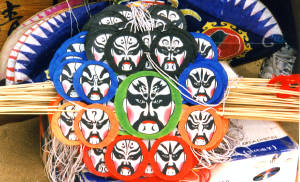
The following evening was the opening ceremonies to the 16th Annual Weifang International Kite festival. At our hotel were 200 international guests hosted by the Chinese city of Weifang for the kite festival. We loaded into large modern buses, and arrived at the stadium. It was packed with close to 80,000 people. We were grouped according to country and were led around the stadium with our country signs and a young woman escort, dressed in a white uniform. After the parade, speeches, the entertainment began. There were two floats, a dragon for the men singers and a phoenix for the women singers. As the entertainers sang, the float drove around the stadium. Dancers, bands and flag twirlers came on between acts. A demonstration of soccer between entertainment personalities and the top soccer team followed. The finale was a large fireworks display. We were told it had been a larger display in previous years, but was shortened because of economic reasons. In any case it was outrageous.
Weifang kite festival pictures
When we returned to the hotel we met Mr. Chen Zhaoji and spent several hours with him and his wife while they showed us their wonderful kites. Scott Skinner met him several years before and bought some of his kites. His painting was airbrushed and interesting and he had awards for his train of goldfish. When he unpacked a mechanical preying mantis (he wanted $1200 for it!) we were very impressed. Gears were fashioned from wire tied to wheels of bamboo. We learned he was a student of Zhang Tian-wei from Xi'an, who we had met in Lianyungang. Chen's stick work was excellent!.
The next morning was the kite flying competition. We went out to a giant field, surrounded by kite fliers. A huge review stand was at one end, and three blimps flew overhead. We unpacked our arch of 1 meter eddy frogs (27 kites in a 200 foot arch, each frog painted according to the colors of different species. Our arch had previously won "most outrageous kite" at the Berkeley Kite Festival in 1997. The wind was too irregular to leave it up unattended so after 20 minutes we took it down to fly other light wind kites. But it was long enough for us to win the Best Kite grand prize at the festival later in the day. It was truly amazing, considering all the outrageous kites we saw in the air that day. We saw kites that never left the ground, dragons with heads as big as people. Dragon kites as long as 1/4 to 1/2 mile, with sections attached. One was so big that to get the kite down, giant tong tools were used that clipped around the 3 flying lines, and pulled the kite down disk by disk, one person holding the center one, the next pulling down the next section, while the first one unhooked the disk when it reached the ground and moved to the back of the line. Once down, more people helped keep them on the ground. Sections were unhooked and packed away. Quite a process.
Our last day in Weifang we went to a kite factory where we saw how they make the bamboo frames and paint the silk designs. A final visit to Pan to buy last things and then off by train back to Beijing for our last two days of site seeing.
Beijing
We reconnected with Yang and Li Hua, Edo, Bill and Joan for a last night in Beijing before they returned home. During the coarse of the evening we mentioned Leng andHa to Yang as Beijing kite artists we wished to meet if possible. Ha and his father had written the book Chinese Artistic Kites. We had also seen one picture of one of Leng's unusual kites in Kite Passion Dec/Jan 99 (Made in China)where there was an article by Zöe Harris with photos by Pierre Fabre. After about an hour on the phone Yang connected with both of them, so our last day in Beijing we opted to spend 8 hours with these two fabulous kite artists rather than see the great wall and other sites. It was well worth it.
Leng Shi Xiang
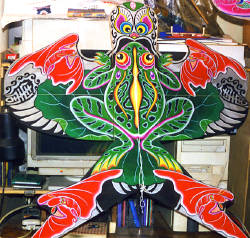 We went to see Leng. His small studio was only a few blocks from our hotel, but it was in an area that had not yet met the wrecker's ball, Old Beijing. His studio was in a small 10 by 10 one story dwelling set back off the streets, and thru many halls and doorways. There was a high skylight in the ceiling, perfect for an artist. The best way to describe Leng's work is that it is like a mix of Picasso, Dali and Miro on kites. His kites ranged from large swallows with sections that clipped on so the kites could be transported, to very small ones the size of your fingernail. He spent two years making these tiny kites. He painted them all with his naked eye. He has been making kites for over 40 years. His stick work was perfect. Some of the best bamboo work I'd ever seen. Some of his kites were asymmetrically symmetrical. One kite was all in black and white, and had never been out of his studio. He never sells his kites, but a few have been shown in museums.
We went to see Leng. His small studio was only a few blocks from our hotel, but it was in an area that had not yet met the wrecker's ball, Old Beijing. His studio was in a small 10 by 10 one story dwelling set back off the streets, and thru many halls and doorways. There was a high skylight in the ceiling, perfect for an artist. The best way to describe Leng's work is that it is like a mix of Picasso, Dali and Miro on kites. His kites ranged from large swallows with sections that clipped on so the kites could be transported, to very small ones the size of your fingernail. He spent two years making these tiny kites. He painted them all with his naked eye. He has been making kites for over 40 years. His stick work was perfect. Some of the best bamboo work I'd ever seen. Some of his kites were asymmetrically symmetrical. One kite was all in black and white, and had never been out of his studio. He never sells his kites, but a few have been shown in museums.
He showed us a frog box kite he won first prize with at Lianyungang the day of the national kite festival! Another victorious frog kite. His kite work was some of the most original work we had ever seen. His miniatures were exceptional. His studio was exactly the kind of place where you'd expect to find an artist, say in the late 1800's in Paris. Paints, paintbrushes, materials, all tucked away in shelves and nooks of the studio. Warm, and full of creativity, with art everywhere.
Ha Yi Qi
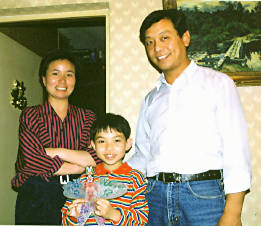 After leaving Leng we were so impressed we thought we'd seen the best China had to offer. We were in for quite a surprise. We had read Mr. Ha's book on kites and went to meet the son, the elder Ha having passed away several years ago. Ha lived across town, near the outer suburbs of Beijing in a housing project. The stairway was dark and dusty, the streets being completely torn up. Ha, his wife and son greeted us with the usual tea and biscuits. Ha started showing us small kites he had painted.. All in the range of 5-10 inches in length. All were very traditional kites.. usually swallow tail with very traditional images on them. The paper was an ultra thin gossamer cotton paper so thin that light passed through the fibers. It is hard to imagine how much skill is involved in painting the intricate detailed paintings so precisely with paper that bleeds so easily. Ha then showed us drawings from a new book that he is preparing. As we discussed things we'd seen in China we showed him a multiwhistle whistle we'd obtained from Pan. Ha then brought out his collection of different whistles!! Most amazing..
After leaving Leng we were so impressed we thought we'd seen the best China had to offer. We were in for quite a surprise. We had read Mr. Ha's book on kites and went to meet the son, the elder Ha having passed away several years ago. Ha lived across town, near the outer suburbs of Beijing in a housing project. The stairway was dark and dusty, the streets being completely torn up. Ha, his wife and son greeted us with the usual tea and biscuits. Ha started showing us small kites he had painted.. All in the range of 5-10 inches in length. All were very traditional kites.. usually swallow tail with very traditional images on them. The paper was an ultra thin gossamer cotton paper so thin that light passed through the fibers. It is hard to imagine how much skill is involved in painting the intricate detailed paintings so precisely with paper that bleeds so easily. Ha then showed us drawings from a new book that he is preparing. As we discussed things we'd seen in China we showed him a multiwhistle whistle we'd obtained from Pan. Ha then brought out his collection of different whistles!! Most amazing..
These kites were very traditional in every sense and preserved some very ancient styles.
After meeting Leng and Ha we felt we had just met the ultimate masters in the world of kite painting. Each was excellent, though the approaches were exactly opposite. Never before and certainly not since have we seen art as beautiful as those of these two humble kite artists.
Japan
Flying from Beijing to Japan we saw a magnificent sunset. There was a cloud bank over the island and the snow capped top of Mt. Fuji rising above the clouds. The sun was setting as a large orange ball right beside the top of Mt. Fuji. An incredible eye catching event, a good omen. This set the tone of our travels for two weeks in Japan.
Fujisaki
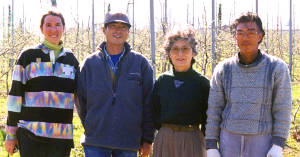
Jennifer with our host family:Kango, Nobuko, and Kazumasa Karouji
We set out the next day for Aomori via bullet train, and two smaller connecting trains. Our destination was the town of Fujisaki, home of Mrs. Tokuko Sato, host of the Tsugaru kite makers and 4 year old local festival. Fujisaki is located in the northernmost part of the main island of Honshu. This kite festival is timed to coincide with the local cherry blossom festival, a very important event in the Japanese calendar. The cherry blossoms are later here than in southern Japan, so it was just in full bloom as we arrived. The neighboring town of Hirosaki, home of the cherry blossom festival, has some 5000 cherry trees, some of which are over 300 years old. Traveling north by bullet train along the east coast from Tokyo, we witnessed the regression to early spring with fruit trees just starting to bloom. Rural Japan has a beautiful clean organized feel to it. Housing with glazed tile roofs, huge carp windsocks blowing in the wind, snow capped mountains along the interior. The trains are immaculate, people warm and friendly and very helpful. We felt very relaxed.
We were met at the train station by Dr. Jinya Sato, husband of Mrs. Sato, and a local dentist of some renown. Mrs. Sato is an important figure in kite painting in Northern Japan and has come to the US several times teaching traditional kite painting classes. Jennifer attended her class at Ft. Warden Kite Workshop and was greatly influenced.
The group of international flyers traveling with Masaaki Modegi arrived and we were all graciously given a good nights sleep at the Sato's house. This group was comprised of Mel Edlund, Wayne Pattison from Canada, David Gomberg, Cathy Goodwind, Glen and Tanna Haynes, Bob Umbower, Charmayne Cornell from the US, Barry (Bazzer) Poulter from Great Britain, and Anne Whitehead from New Zealand
The next day we went to the local community center where most of the group learned about Kimono dressing, ikebana flower arranging, and tea ceremony. Since Bob had been to Japan several times he took the time to visit with the workmen who hung the tsugaru kites Mrs. Sato and her students had painted. He was able to photograph many of the kites that never made their way to the walls. A very private showing indeed.
Later in the day each of the international guests were to make food for the ceremonial dinner that night. Everyone including Modegi pitched in and made all sorts of food.
The ceremony kicked off with locals and kite clubs attending, speeches by the Mayor, and local officials. In true Japanese fashion there was sake, beer, dancing, and singing karaoke style. At the end of the night we met the host family we were to board with for the next few nights. Staying with host families was a fabulous idea. This way you interact with the local folk in a most intimate way. A wonderful cultural exchange. The family we were paired with was a Fuji apple farmer with a very large apple farm. The house was beautiful and heated by wood, just like our home in Inverness, California. We slept on futon's covered by down comforters, with the windows open to the clean cool air. In the background Mt. Iwacki with its snow covered peak, rose above the valley like Mt. Shasta along the central California valley. The air was cool and crisp and life seemed quite peaceful.
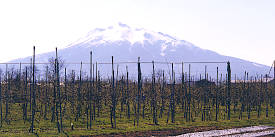
Mt. Iwaki and Fuji apple orchard
The following morning we set out for the kite festival with our host family. It was set on a flat field along a river with about 300 people attended, mostly local fliers, and 30 international guests. Once the breeze came up we were able to witness the tsugaru kites, which the region is famous for. These kites are rectangular, made of cypress slats and bowed at the top. They have long hemp rope tails for stability-real long tails- and there is a hummer on the top created with a piece of stiff paper. This flaps in the breeze as the kites are pulled high in the sky, and have a loud sound almost like a locomotive coming down the tracks. The fliers allow the kites to sink to the ground and pull them up again rapidly to create the sounds. It was a sweet festival, with plastic kites made for the children, and all sorts of traditional Japanese foods, plenty of room, nice folks, and good weather. Many thanks to Dr. and Mrs. Sato for a good old fashioned Japanese festival.
Later we rendezvoused for the traditional cherry blossom festival evening walk around Hirosaki Castle. The cherry blossoms hadn't dropped a single petal, so it was maximum blossom time. The setting was at a local castle, high on a hill, surrounded by a moat. The tree lined lanes were lit from below by large lanterns. An incredible eye filling site that was a pure delight.
The next morning we traveled to Kanazawa, near the town of Uchinada where the International Kite festival is held on the beach. This is the festival Modegi works with each year to gather fliers from all parts of Japan and international guests. Traveling south along the west coast of Japan on a slow local train was again an exercise in beauty. Snow capped mountains, the Alps of Japan were on the inland side, with the calm smooth Sea of Japan on the other. Small villages set down in the canyons dotted the landscape to the sea. A wonderful train ride not to be missed if at all possible. It even travels by the town of Shirone which has a huge kite museum.
The town of Kanazawa is the untouristed Kyoto of the west. We thought there was something different when we first noticed a good number of expensive cars, a large number of crafts stores, art galleries and boutique stores. In the morning we went to the local farmers market. The produce and food was displayed in typical Japanese organized fashion. This region seemed to be noted for crabs and we saw huge crabs, hairy crabs, all sorts of them for sale. We set out from there with supplies for lunch and dinner, and walked the town. Kanazawa has walking tours set up with signs in English and maps of where you are, so getting around was very easy. Jennifer visited the Kutani pottery kilns she studied in art school and loved. We visited the exquisite silk dye painting workshop, museums with famous pottery, and each little shop was like a mini gallery. Quite an unexpected delight. A town not to be missed.
Uchinada
We linked up with Edo (Ed Fackler) and rode to Uchinada, to get ready for the upcoming kite festival. We were glad we arrived early as it gave us time to scope out the beach and fly kites for two days before everyone descended. There were a few other dedicated flyers who had arrived early and we had both the time and space to investigate each others kites extensively. We met a 75 year old Edo kite maker from Gunma, who was a second generation Edo master. We talked about kites, history, harmony and how to fly Edo kites. In about 30 minutes we learned more about Edo kites than from all the books we've read. We met the master Sode (kimono) kite master. These beautiful kites had large hummers, similar to the ones on the Balinese kites.
 The day of the festival opening ceremony arrived, and a big party was held in the local community center. Speeches, introductions, food, drink and a large kite auction were the agenda for the night. Kite clubs from all over Japan attended, with 300 in attendance.
The day of the festival opening ceremony arrived, and a big party was held in the local community center. Speeches, introductions, food, drink and a large kite auction were the agenda for the night. Kite clubs from all over Japan attended, with 300 in attendance.
We linked up with the Osaka kite club, Edo (Ed Fackler) is a member, and whose members we had met several years before at a kite festival in San Francisco.
San Francisco and Osaka are sister cities, and two years ago, a prefecture office was opened in San Francisco. To celebrate this the Osaka kite club set up kite making classes for children which we attended. Tosa (handkerchief) kites were made. The club set up a display of traditional kites from Japan that were instructional and incredible in their artwork. The mayor of Osaka arrived, and 1000 Tosa kites were handed out in red and white, half of which said San Francisco, and the other half said Osaka.
Seeing the Osaka club members in Uchinada was like an grand reunion for us. We traded kites, happi coats and reaffirmed our friendship.
It rained the festival day so there was limited flying. Most of the Japanese paper kites could not be flown, and the Osaka club decided to return early. We hitched a ride with them on their bus as we were headed in that direction. We had a grand 8 hour bus ride on Jennifer's birthday singing songs all the way to Osaka.
Nara
The following morning we visited our friend Miki in Nara.
Miki has done artwork for Ty Billings and the Grateful Dead. Miki is also a frog lover and collector. When we met Miki in Nara it was a 2 hour frog trading session before we even left her house to check out all the frog stores she knew in the area. A frog blast!! The Japanese word for frog is Kaeru (kai-ru). Miki arranged for us to visit a local kite maker's studio and museum in Nara.
Seiho Nakamura
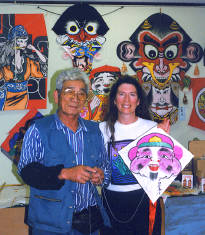
Jennifer with Seiho Nakamura
Mr. Muneyuki Nakamura (Seiho is his nickname). After a brief train and bus ride, Seiho met us and drove us to his studio. He was a kite master who had just won first prize the previous month in a kite festival in Aomori!. Seiho is 76 and recently retired (his wife now runs the transport business he owns) so he could devote himself to kites. He teaches kite making to kids, and has a wonderful studio with all sorts of traditional kites from all over Japan. Seiho showed us how he painted kites, how he worked the bamboo. He invited us to come back next year and work in his studio and fly kites for his birthday kite fly next May. We hope we can make it!!
Yokkaichi
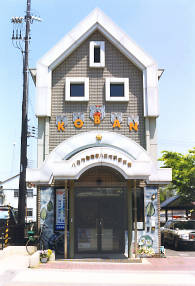
Yokkaichi police station-with kites above the letters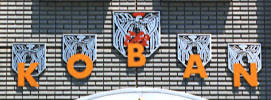
We met Katsuhisa Torii at the Uchinada ceremony, the curator of the World Kite Museum- Yokkaichi Oodako Hall. Since it was only about two hours from Nara, we rode off the next day to the town of Yokkaichi, home of the big kite oodako kite festival. Oodaka means giant kite. These enormous kites were for many years the largest kites in the world. In 1984 a kite the size of 220 tatami mats was made and flown to celebrate the 30th anniversary of Yokkaichi City. (This kite was approximately 26.5 meters by 28.5 meters). The kites are so big they are rolled up and loaded into a truck by fork lift for transporting to the flying field. The whole town participates. Of course there are images of the famous oodako kites on the water mains, the police station and banners in town. There is even a phone card for the oodako kites. The kites typically have symbolic animals on the top, with a Kanji character below. The character is in red and is usually cut away so air passes through it. Last year (in 1998) it was two doves for world peace, and this year it is two fish (carp) for the green earth. These kites are like giant edo kites with long hemp rope tails (at least 30 meters) for stability.
The museum is a modern building with one tall side, with a clerestory of glass. This is ideal for housing the tall oodako kites. Smaller versions of the images of many of the past festivals adorn the walls. The ropes and reels used to fly these giant kites are enormous. One year for the 150 memorial of the record fly (largest kite) from the 1800's, an exceptionally large kite was made and launched from two cranes and held by a fire truck.
The museum houses an excellent collection of kites from all parts of Japan. We watched two videos of the kite festival. The whole process of making the kite is fascinating. It is a team effort with about 25-30 people leading the process. Individual sheets of rice paper are glued together to make the kite skin. The skin is placed on the floor and green cat litter like material is laid out in the shape of the design. The design has been drawn and tiled so it can be enlarged. By using the "litter" the design can be adjusted to the correct shape, and then outlined in ink. The litter is removed and the painting begins. A criss-cross of string is glued to the skin to reinforce it. The paper is cut and glued back in the cut out areas. The horizontal sticks are inserted and tied so the bridle can be attached to them. The bridle is attached, the kite rolled up and carted off to the festival. It is rolled out on the field, final (vertical) sticks are tied in, and then raised to the full height by hand on bamboo supports. Finally it is hoisted into the air by a team of 100 people pulling along the line, running to get it into the wind. As the wind catches the kite, a cheer fills the air, and everyone is filled with joy. This year alas, there wasn't enough wind, and it could not be flown. Such is the fate of a sport which depends on nature.
Tokyo
The last few days of our tour we spent in Tokyo, seeing the sights, visiting toy stores and going to the kite museum run by Masaaki Modegi. It was started by his father in the building he has his world famous restaurant. The museum is so packed with kites, it was hard to take photos. So we just have a few picutres. One of the highlights was a mock up of the studio of Tazio Hashimoto.
Our travels through Japan were incredibly beautiful and heartfelt. We hope to return to attend the Shirone kite festival next summer.
Thank you!!
Our travel to China and Japan was so wonderful largely due to the help of so many wonderful people. We would like to share with you who these people were.
China
Sui Shude-our connection via the internet who arranged for us to be met at the airport, hotels, got our train tickets, and made it all seemless.
Liu Yu Kui-the section chief of the Weifang kite festival, our dear friend who helped us in Weifang, and created a wonderful kite festival
(Paul) Liu Jiang-our guide and diligent interpreter in Weifang, and son of Liu Yu Kui. Paul was the man of the moment when we won the Best Kite award at the 16th Annual Weifang Kite festival.
Pan Bo Hua-a fabulous kite maker in Weifang, who we managed to see every day for 3 days, and whose son we flew with last year in Colombia.
Li Hua and Yan Huan Xing-without whom we would never have seen the fabulous kite masters in China.
Japan
Masaaki Modegi-President of the Japan Kite Association, a cheeful kite spirit, man about town, and the person we depended on when we needed him most to assist us.
Teruaki Tsutsumi -a wondful, playful person who made our trip in Japan lighter and more fun. He is the person behind the scene for the Tokyo Kite museum and the Japan Kite Association for Modegi.
Dr. Jinya and Mrs. Tokuko Sato-hosts, organizers of the Fujisaki festival, loving supporters of traditional kite making in Japan.
Kango, Kazumasa, and Nobuko Karouji- our host family in Fujisaki, whose warm hearts and wonderful Fuji apple juice made our stay there unforgettable.
Seiho Nakamura-kitemaker extraodinaire, who opened his studio to us, and his heart as well.
Katsuhisa Torii- curator of the Yohkaichi oodaka museum, who showed us his fabulous museum and helped us find the awesome Dragon Tabbi boots
Masao Hashimoto-President of Osaka Kite Asscociation, host of the 8 hour karaoke bus ride to Osaka from Uchinada, and friend since he and his club came to San Francisco in 1996.
David Gomberg-former President of the AKA, who assitance opened doors for us at Weifang.
Tomas Sasaki-our dear friend of many years, who helped clue us in to the ways of the Japan kite world.
Edwin Fackler-our fearless travel companion in China and guide to the way of Japan.